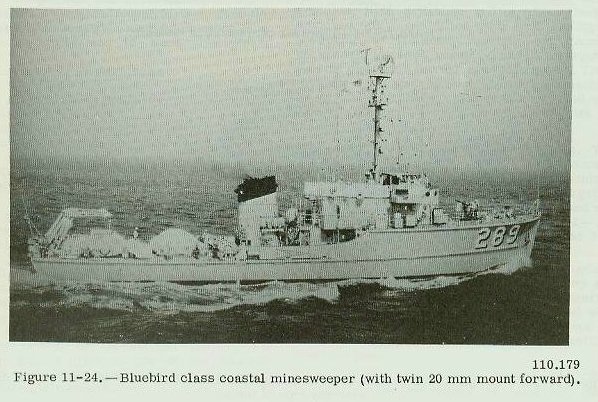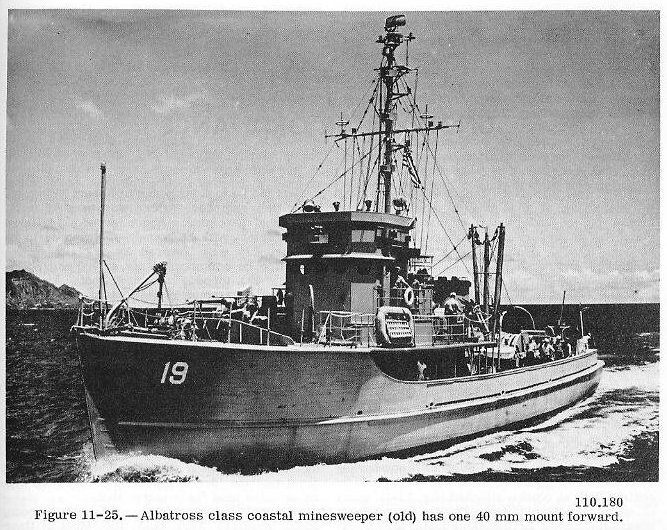
Throughout our history coastal and riverine craft have played a very important part in achieving victories, on sea and shore. This has been true from the American Revolution to the Vietnam conflict. Coastal and riverine craft, many of which were converted from World War II landing craft, have been used extensively in the Vietnam conflict. Their armament, which varies from craft to craft, ranges from .30 caliber machine guns to 105 mm howitzers. This chapter will acquaint you with some of these and their armament, including its operation. Keep in mind that most of these craft are of a temporary nature - activated and built only for use in the Vietnam conflict - and may or may not be in service once the Vietnam conflict is over. However, future involvement in a similar type of warfare may again require their use.
Coastal craft include patrol gunboats (PGs), hydrofoil gunboats (PGHs), fast patrol boats (PTFs), and fast patrol craft (PCFs). (Some coastal craft, such as the PTF and the PCF, also may be used for riverine service.) A representative number of these craft and their armament will be briefly discussed in this section. Again, keep in mind that the armament on one boat may be different from that on another boat of the same type.
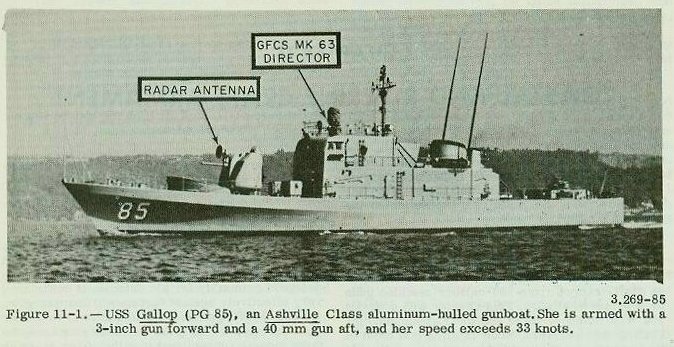
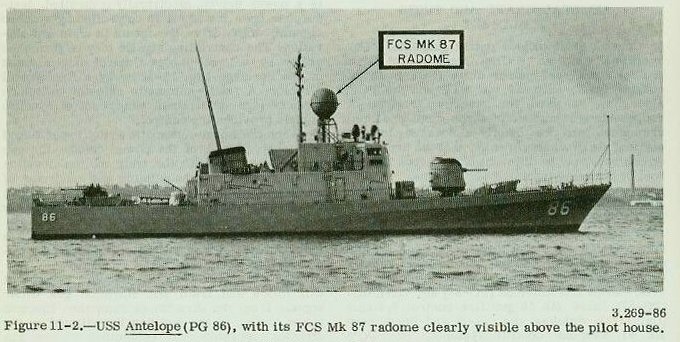
A patrol gunboat’s armament consists of a single 3”/50 gun mount forward, a single 40 mm gun aft, and four .50 caliber machine guns in twin mounts atop the pilot house. Ashville Class PGs, except USS Antelope (PG-86) and USS Ready (PG-87), have Mk 63 gun fire control systems (fig. 11-1). Antelope (fig. 11-2) and Ready have Mk 87 weapons control systems. The PG’s weapons are capable of inflicting heavy damage upon light shipping and enemy personnel ashore.
The 3”/50 used on patrol gunboats (fig. 11-2) is a rapid-fire, semiautomatic, enclosed single gun mount. Although the 3”/50 gun was designed primarily for air defense, it can be used very effectively against surface and shore targets. The 3”/50 gun on a PG is enclosed in a fiber glass shield; 3"/50 guns on other ships may be open mounts or enclosed in either fiber glass or aluminum shields. The description and operation of the 3”/50 gun are covered in chapter 5.
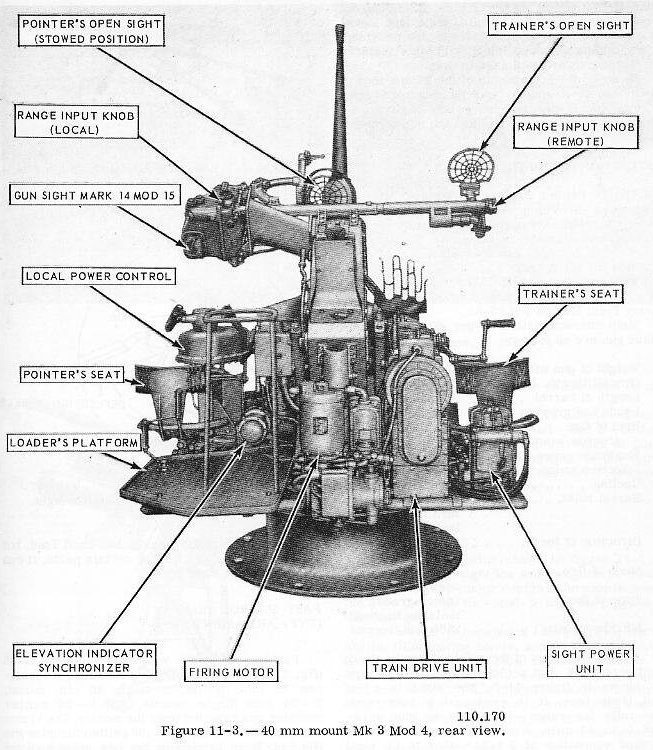
The single 40 mm mount (fig. 11-3) on the PG is a power driven, electrically controlled, dual- purpose open mount. It is controlled by synchro signals, which drive the mount in train and elevation. The controlling signals may be furnished either by a Local Power Control unit mounted on the carriage (fig. 11-3) or by a fire control director. A Local-Automatic selector switch on the carriage determines which set of synchro signals provides the control. When the Local-Automatic switch is positioned for local control of the power drives, the gun pointer controls both the train and the elevation power drives by manipulating the handgrips of the Local Power Control unit. The pointer tracks the target with a gunsight that is mounted on the gun mechanism and moves with the gun. He may fire the gun electrically by depressing a foot-operated firing switch or manually by depressing the foot-firing pedal. When the mount is in automatic control, it will follow the train and elevation gun order signals from the director or computer. Electric power firing of the gun can be initiated by the director operator and controlled by the gun crew. Manual gun operation by handcranks is possible whenever power operation is not feasible. Various safety features such as power-to-manual interlocks, securing pins, firing cut-out cams, power-operated limits, train and elevation positive stops, and buffers are provided. These safety features, along with other features of the mount, are explained in detail in OP 1289. Some of the components of the 40 mm mount, such as the trainer’s and the pointer’s open sights, local and remote range input knobs, Local Power Control unit, and the gun sight are shown in figure 11-3.
The .50 caliber machine gun on the patrol gunboat is a Browning recoil-operated, belt-fed, air-cooled gun. Although it is primarily an antiaircraft weapon used by the Army, the Navy has adopted it for use aboard ship, against both surface and air targets. The mechanism of the weapon and its principles of operation are described in detail in Army Field Manual FM 23-65. Main characteristics of the .50 caliber machine gun are as follows: Weight of gun with barrel...84 pounds Overall length...65 1/8 inches Length of barrel...45 inches Lands and grooves...8 each Rate of fire (rounds/minute)...500 Maximum range...7,400 yards Effective range...2,250 yards Cooling...Air Barrel twist...Right hand; one turn in 15 inches Direction of feed...Optional (left or right) Mode of fire...Full automatic or semiautomatic Type of feed...Disintegrating metallic link belt Muzzle velocity...2900 feet/second The gun normally uses a left-hand feed, but by changing the position of certain parts, it can be fed from the right side.
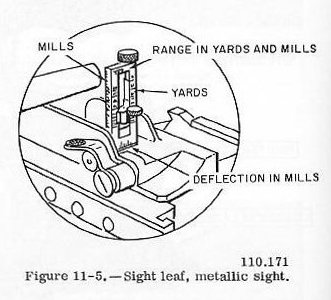
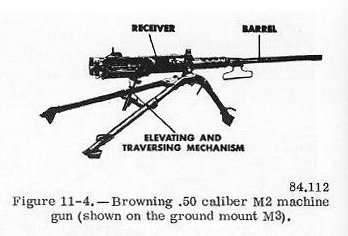
An exterior view of the machine gun is shown in figure 11-4, and a closeup of the rear sight is shown in figure 11-5. The sight is a leaf and blade type. It is graduated in both yards and mils for range-from 100 to 2600 yards and 0 to 62 mils. A windage screw allows for a wind correction of 5 mils either to the right or the left.
Fast patrol boats with hull numbers 17-26 (fig. 11-6) have the following installed ordnance: one 81 mm mortar, a single 40 mm mount, 2-20 mm single mounts, and 1-50 caliber machine gun mounted over the mortar. The 81 mm mortar with its piggyback .50 caliber machine gun (fig. 11-7) is located in the bow section of the boat. One of the 20 mm guns is mounted on the starboard side and the other is mounted on the port side.
PTFs with hull numbers 3-16 have 2-40 mm guns - one forward and one aft - and 2-20 mm guns - one to starboard and the other to port.
(The .50 caliber machine gun is the same weapon as the one described earlier. Therefore, it will not be discussed further.)
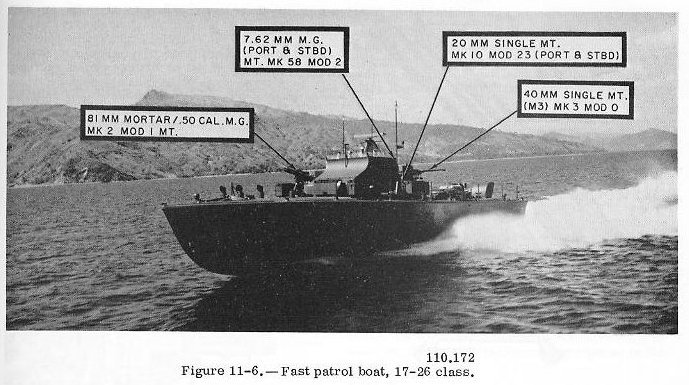
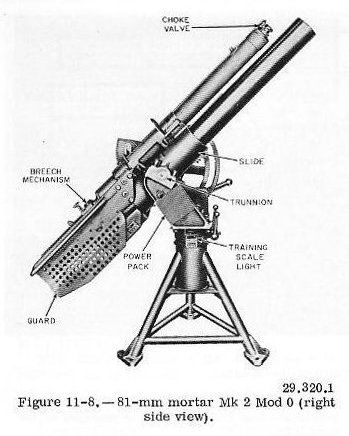
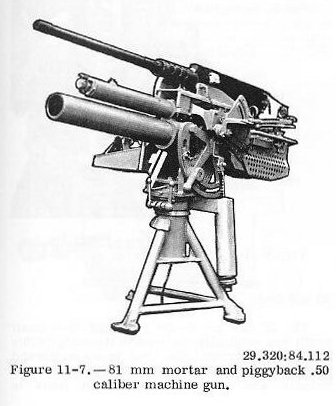
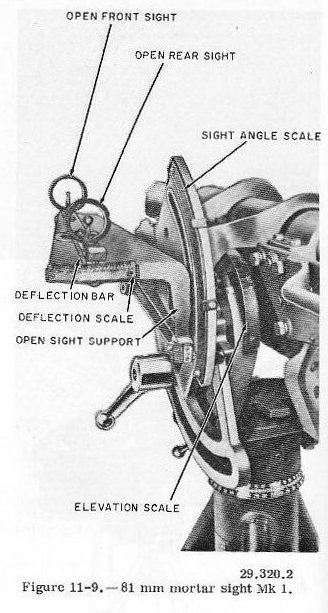
The 81 mm mortar has an open yoke-type sight mounted at the left side of the slide (fig.11-9). It is a manually-adjusted arrangement with offset limits of 14° 20’ deflection, right and left, and 75° sight angle. The mortar has an elevation scale that is graduated in 5° increments from -30° to +75° and a training scale graduated in 1° increments from 0° to 360°. Additional information on the 81 mm mortar, which is also mounted on Hydrofoil Gunboats (PGHs) and Fast Patrol Craft (PCFs), can be found in OP 1743.
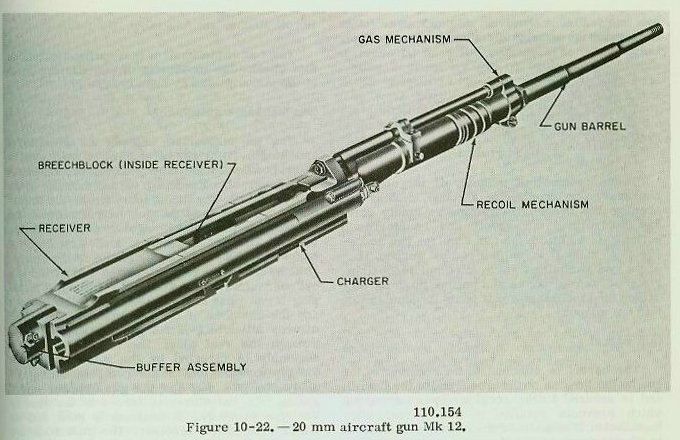
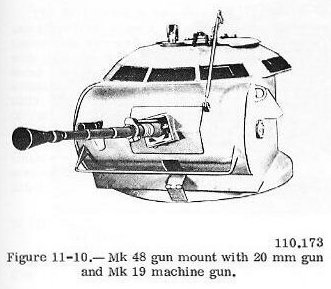
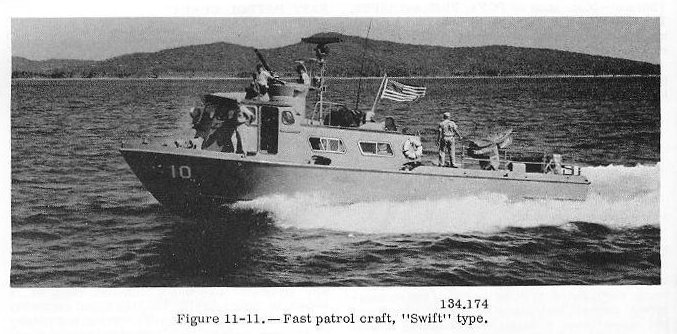
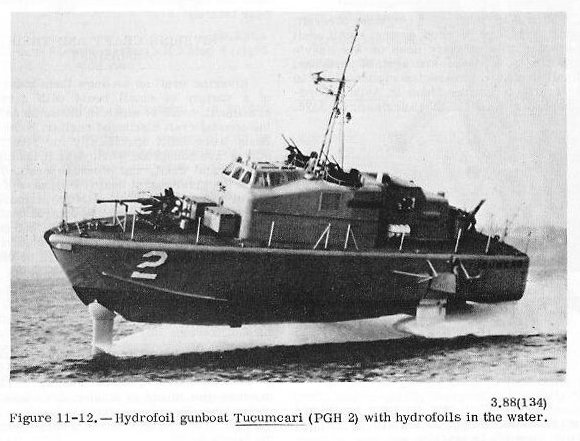
Riverine craft as we know them today consist of a variety of small boats with a variety of armament, much of which is the same as that for the coastal craft discussed earlier. Some of these boats were built specifically for riverine use; others are converted World War II landing craft, commercial craft, and pleasure craft. They include the river patrol boat (PBR), assault support patrol boat (ASPB), monitor (MON), armored troop carrier (ATC), command and control boat (CC B), patrol air cushion vehicle (PACV), and the river minesweeper (MSR). The armament of a representative number of these craft will be discussed in the following paragraphs.
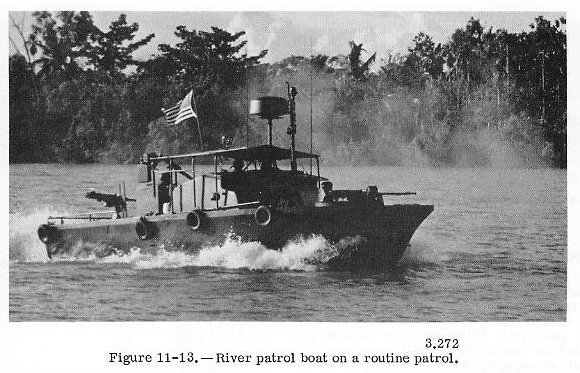
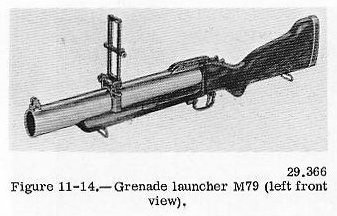
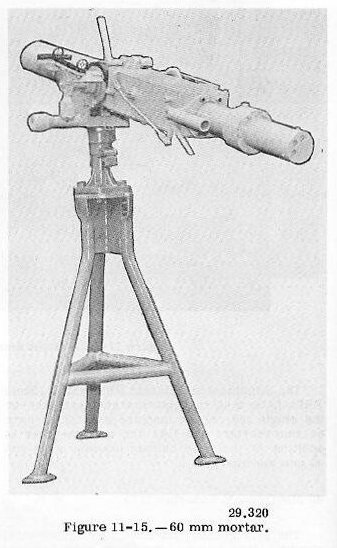
Weight...135 pounds
Length...54 1/4 inches
Width...14 inches
Height...57 3/4 inches
Mode of fire... drop or trigger
Type of feed...hand
Rate of fire...10-18 rounds per minute
Maximum range...1,850 yards
Effective range...1,000 yards
Muzzle velocity...493 feet per second
Barrel twist...none
Barrel length...25 5/8 inches
Cooling...air
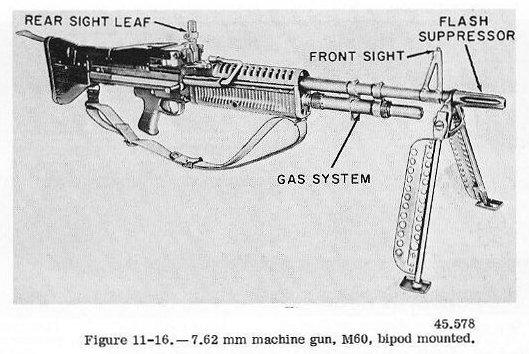
Caliber...7.62 mm NATO (.308 caliber)
Weight...22 pounds
Length...43.5 inches
Width...3 inches
Height...5 inches
Mode of fire...automatic
Direction of feed...left hand
Type of feed...ammunition can
Rate of fire...550 rounds per minute
Maximum range... 3,200 meters
Effective range...1,100 meters
Muzzle velocity... 2,750 feet per second
Barrel twist...right hand, one turn in 10 inches
Barrel length...24 inches
Cooling...air
Some PBRs, as well as other small boats, carry night vision equipment, small arms, pyrotechnics, and demolition grenades. The night vision equipment (sight) is used to see enemy movement at night or during poor visibility conditions. It is hand held or mounted on the M16 rifle. Small arms carried by the PBR consist of a 12 gauge shotgun, 3-M16 (5.56) rifles, 2-40 mm grenade launchers, a .38 caliber revolver, and an ordnance locator. The small arms are especially useful for boarding and search operations. The pyrotechnics are used for signaling, by smoke or Illumination.
The miscellaneous ordnance carried by any boat at a given time will vary according to its assigned mission.
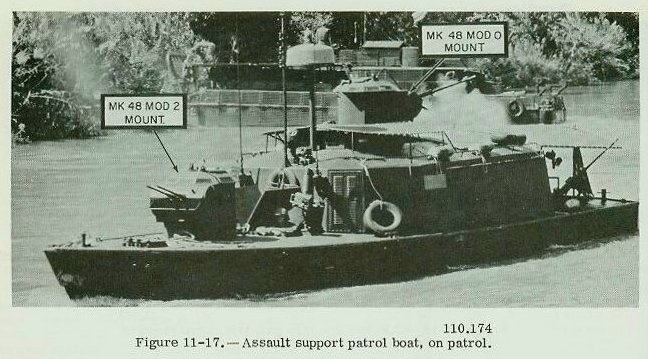
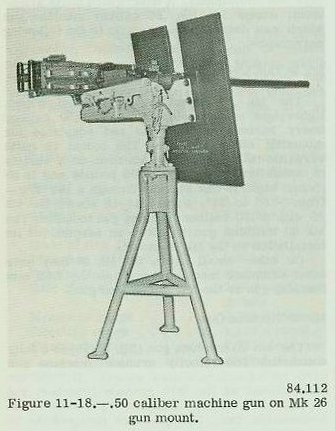
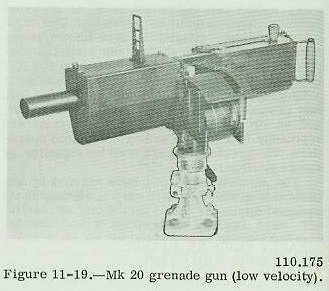
Caliber...40mm">
Weight...26 pounds
Length...27inches
Width...9inches
Height...7 inches
Mode of fire...full automatic or semiautomatic
Direction of feed...left hand
Type of feed...mechanical, link
Rate of fire...250 rounds/minute
Maximum range...400 meters
Effective range...350 meters
Muzzle velocity...2950 feet/second
Barrel twist...right hand, one turn in 48 inches
Barrel length...12 inches
Cooling... air
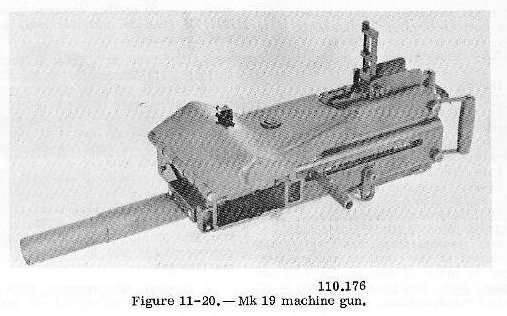
The Mk 48 gun mount is a medium-armored, small-caliber, flexible multiple-gun mount for use on small craft employed in patrol, escort, and support duties. The mount provides fire power effective against other small craft as well as personnel and shore emplacements. It has unobstructed peripheral vision for easy target recognition from all angles.
The Mk 48 mount comes in several mods. Its mod depends upon its ordnance suite. The Mod 0 mount has one Mk 19 machine gun and one 20 mm machine gun; the Mod 1 has one Mk 19 machine gun and two 7.62 mm machine guns; and the Mod 2 has one Mk 19 machine gun and two .50 caliber machine guns.
The ASPB in figure 11-17 has a Mk 48 Mod 2 mount and a Mk 48 Mod 0 mount like the one shown in figure 11-10. The mount is 39 inches above the deck. It is manually operated through 360° in train and can be elevated from-15° to 65°(a total of 80°). It has a periscope-type sight for daytime use and a light amplification type for use at night. The Mod 0 (as stated earlier) has a 20 mm machine gun and a Mk 19 machine gun. The 20 mm gun is identical to those described earlier for the fast patrol boat. The Mk 19 machine gun (fig. 11-20) is a mechanically-fed, blowback-operated weapon designed to fire 40 mm high velocity grenades.
It can be fired by hand or remotely by using a solenoid. Its main characteristics are as follows:
Caliber...40mm
Weight...46 pounds
Length...34 inches
Width...8.5 inches
Height...7.5 inches
Mode of fire...full automatic or semiautomatic
Direction of feed...left to right
Type of feed...mechanical, link
Rate of fire...375 rounds/minute
Maximum range...2,200 meters
Effective range...1,600 meters
Muzzle velocity...800 feet/second
Barrel twist...right hand, one turn in 48 inches
Barrel length...12 inches
Method of operation...advanced primer ignition
Cooling...air
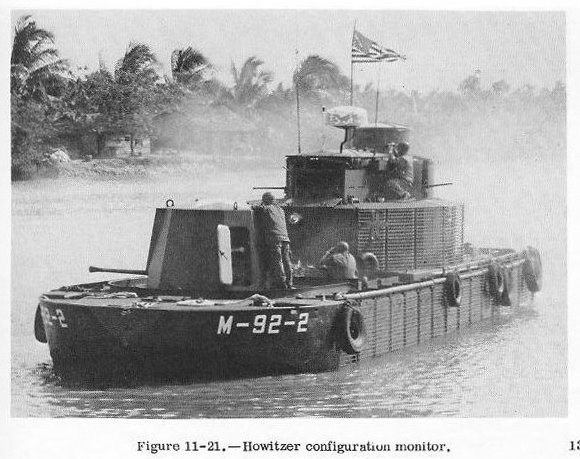
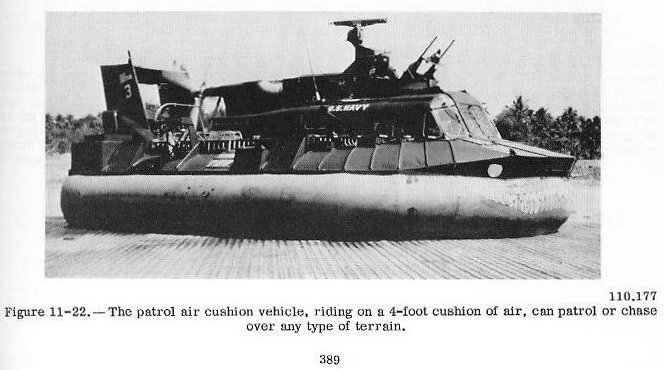
The Navy has several other types of coastal and riverine craft. Some are used for one specific purpose while others have multiple uses. Whether these craft are in an active or a reserve status depends upon the current requirement. Some of these craft and their armament are as follows:
The PACV (fig. 11-22) travels on a cushion of air about four feet thick. Flexible air-actuated trunks provide obstacle clearance and ditch-crossing capability over land and improved riding qualities over water. The PACV has been highly successful in its operation in the marshy plains of South Vietnam. It is armed with a twin Mk 56 .50 caliber machine gun mount, two 7.62 mm machine guns, and two 40 mm grenade launchers.
These craft were converted from LCM-6 landing craft. Their main purpose is to transport troops, small vehicles, field artillery, and supplies. Heavily armored, they are fitted with steel helicopter platforms to facilitate evacuation of wounded personnel, logistics resupply, and as emergency landing platforms for damaged helicopters. Their armament consist of 1 or 2-20 mm machine guns, 2- .50 caliber machine guns, 1-40 mm Mk 19 grenade machine gun, and 2-Mk 20 machine guns.
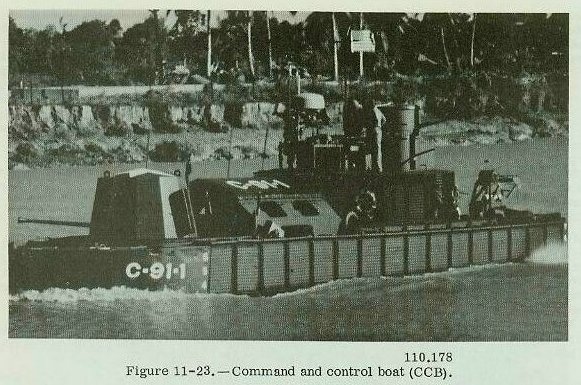
River mine-sweepers are converted landing craft. They are heavily armored craft that are used for clearing mines from the rivers. MSRs are armed with two Mk 48 Mod 0 mounts amidships - one to starboard and one to port- and a .50 caliber machine gun.
